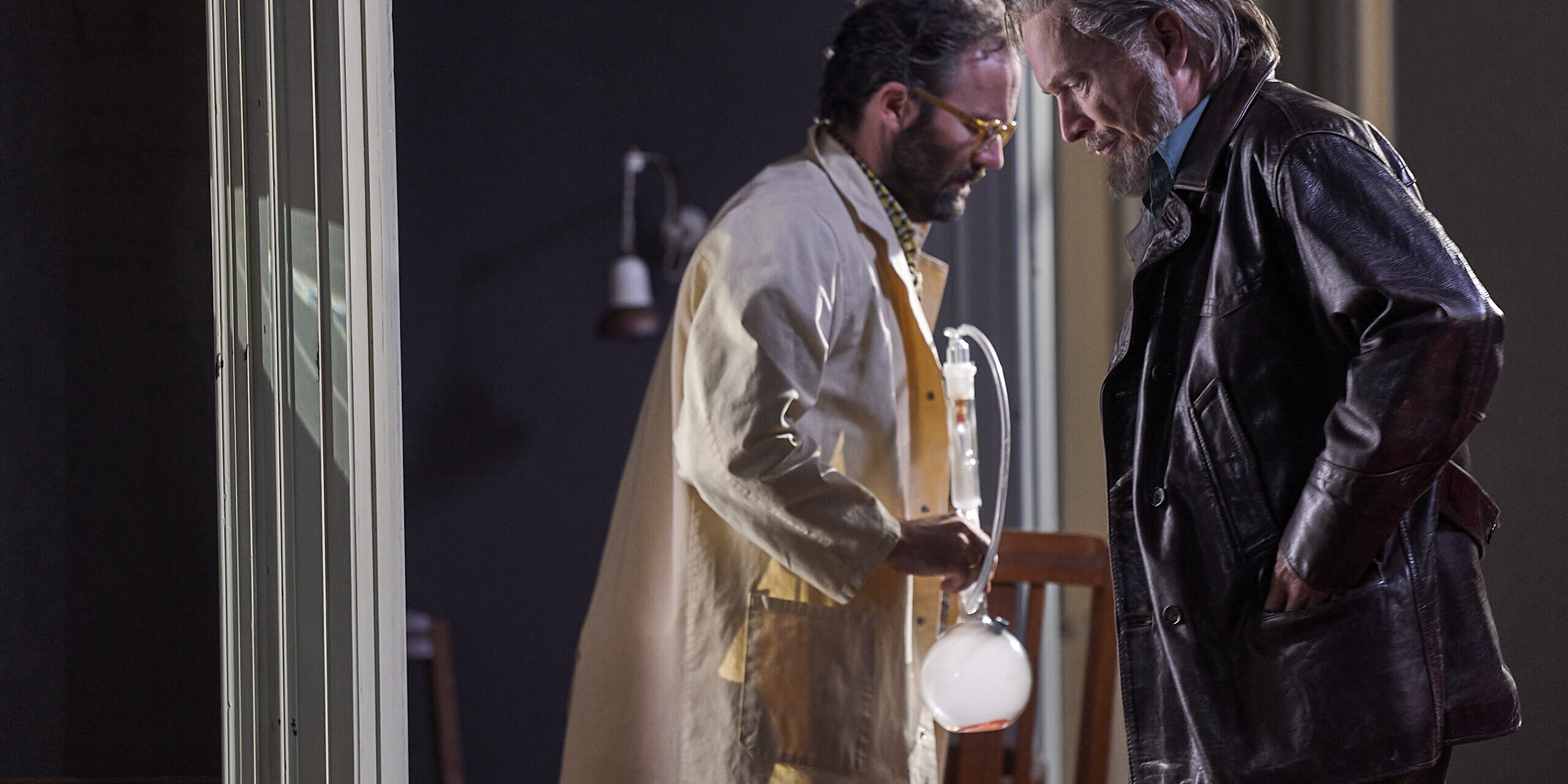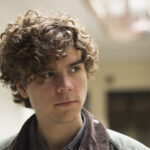This year’s Belgrade International Theatre Festival (BITEF) marked Nikita Milivojević’s first as artistic director. At the end of eight days of performance, Borisav Matić, Andrej Čanji and Natasha Tripney gathered to discuss their impressions of the festival, the highlights and the let-downs.
Borisav Matić: This year’s BITEF, which took place between 3rd and 10th October, was the first one under its new artistic leadership. The Secretariat for Culture of the City of Belgrade abruptly decided in February 2023 not to extend Ivan Medenica’s tenure as the artistic director and selector of BITEF and gave the role to Nikita Milivojević who was in a very difficult position, because he had only a few months to deliver the selection, as the selection was announced at the beginning of June.
This abrupt change in artistic leadership was a controversial and irresponsible decision of the Secretariat for Culture. In my opinion, it was not so because they chose someone else than Medenica but because they gave such a short notice to the new selector – we know that the work on BITEF’s selection should start at least a year before the festival. This, of course, had negative consequences for the work on the festival.
It seems to me that precisely because of this situation, Nikita Milivojević tried to make the selection process as democratic as possible and shared responsibility by creating a curatorial team – he invited the manager and producer Ksenija Djorović and the playwright Tijana grumić as co-selectors.
This year’s slogan “Strength, Don’t Let Yourself Be Anyone’s”, which is a quote from Radmila Petrović’s poem, can be interpreted in various ways. But in the context of the new curatorial team, I think that they are indicating that they will not let themselves be manipulated by the government or anyone else, and they will at least try to make the selection process independent, open and democratic.
How do you see this situation? Do you have any other ideas on how to interpret the slogan?
Andrej Čanji: Well, I find it very sad that once again a political decision is forcing people in the cultural sphere to abide by the government’s decision. In a way and ironically, the new leadership of BITEF has agreed to put its strength in other hands.
Natasha Tripney: Yes, but I also feel that in successfully putting together this festival within the short space of time under pressurized conditions, showed a kind of, if not defiance, then a form of strength. The City of Belgrade’s actions were short sighted, paying no need to the significance of this world class, highly respected festival. They displayed a very vandalistic approach to the arts. So in delivering the festival, and not, say, postponing until next year or presenting a shorter programme, they showed a form of strength.
Borisav Matić: To move from the political context to the programme itself, we have this slogan as an overarching theme, but having seen the first few performances, I felt that they weren’t directly connected to the slogan. The selection was quite eclectic, starting with the festival prologue of Frank Castorf’s The Divine Comedy, a post-dramatic production of the Belgrade Drama Theatre which Ivan Medenica wished to include in the program and the curatorial team agreed. Then we had Mateja Koleznik’s Children of the Sun, a very conventional, old-fashioned realistic performance based on Maxim Gorky’s play. And then we moved to Goodbye, Lindita, a poetic visual meditation on death and funeral customs. There was the historical-dance performance Desire To Make a Solid History Will End Up in Failure, followed by the opera on the climate crisis Sun and Sea and the operetta Singing Youth which explores the ways culture is used for propaganda. #Jeanne was the metaphorical retelling, partly of Joan of Arc’s story, partly of Greta Thunberg’s. We closed with the dance performance Wakatt, a collaboration between Burkina Faso and Belgium.
Do you see any distinct link between these performances? And do you think that the selectors even had the time and resources to develop a clear dramaturgy of the festival, which BITEF had in previous years?
Natasha Tripney: I was always very struck on previous visits to BITEF by the thoughtful way in which the festival was programmed. There was always a sense of being taken on an artistic journey in terms of how shows were grouped, either thematically or formally. The selected performances often seemed to be in dialogue with one another and there was a sense of dramaturgical progression within the frame of the festival. I didn’t really get a sense of that this year. The slogan felt more like a gesture of intention than a guiding thematic principle, which I suppose is one of the consequences of having to put the programme together in such a short space of time.
Andrej Čanji: The previous editions, BITEF always had a concept. The 53rd BITEF focused on immersive theatre, for example, while the 52nd BITEF was themed “World without people”, and featured some installations and performances without actors. The year before that we had a BITEF titled “epic trip” which presented durational performances and so on. Every year had either a formal or a thematic concept. This year’s edition of BITEF felt heterogeneous and without focus, no doubt because of the lack of time for preparation.
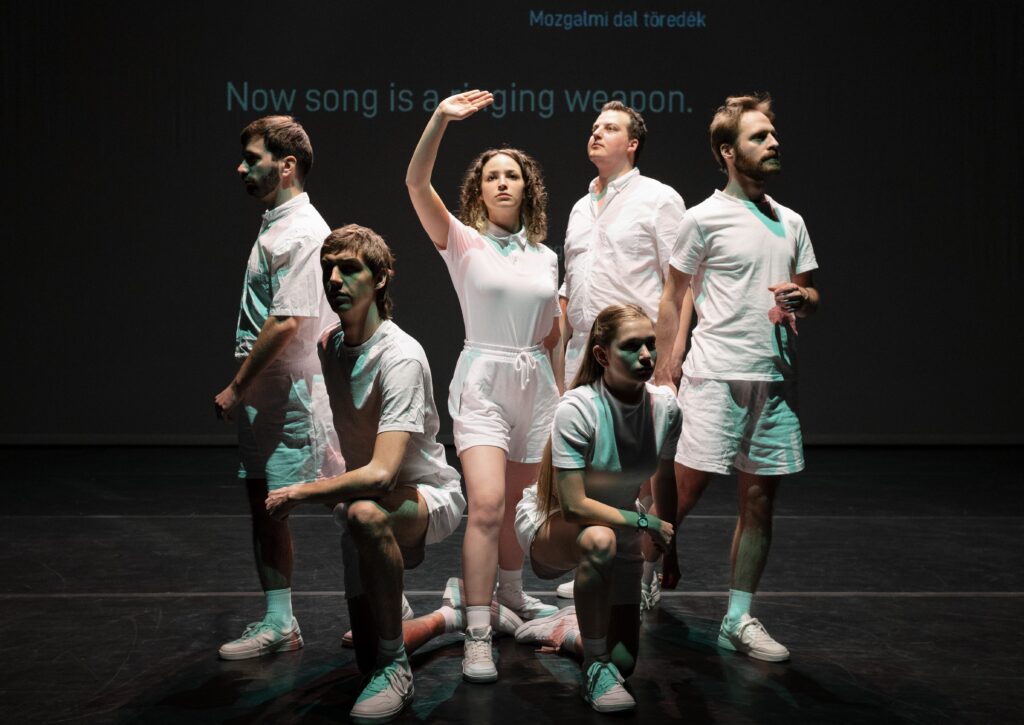
Singing Youth
Natasha Tripney: Some of the strongest pieces this year featured music in a very prominent way, both the opera Sun and Sea and the operetta Singing Youth, but also Wakatt, this dance piece which was very musically-driven and jazz infused. Do you think this reflects the team’s artistic tastes?
Borisav Matić: BITEF this year had quite a diverse curatorial team, but I think they mostly lean towards dramatic theatre. Tijana Grumić is a conventional playwright – I mean that in the best possible way; in the sense she’s not an experimental playwright. Ksenijaa Djorović, who mostly works on the independent scene, is a producer. And of course, Nikita Milivojević is a director of dramatic theatre who mostly bases his performances on classic texts, even though he often has strong visual and musical elements in his shows. I must say I think that they really made an effort to select the performances that are perhaps not their cup of tea but fitted into the concept of BITEF.
I think that musical performances, as you mentioned, were really the strongest in this year’s selection. The opera Sun and Sea is in my opinion the best show this year. It’s not just about the climate crisis, but it’s also about contemporary working conditions and burn out. It explores the conditions of late capitalism. And it’s striking how we observe all these dynamics in the show by simply watching people lying on the sand at the beach and hearing them sing about these problems.
The operetta Singing Youth, an independent production from Hungary, is also very poignant political piece about the ways culture is used as propaganda, which is also delivered exclusively through through singing. And the performance Wakatt from Belgium and Burkina Faso was interesting for its use of a jazz concept, in terms of the improvisation, or perceived improvisation, of the live band and the dance that accompanied it.
Andrej Čanji I completely agree with both of you that the opera performances were the most interesting. I can’t help but again make a comparison between this year’s edition and the previous ones. When you have a lack of strong concept it makes the weak performances seem even weaker. Last year at BITEF, for example, there were also some weak performances. Tijuana, a performance from Mexico, was to my mind not very impressive. The actor Lázaro Gabino Rodriguez described his experience of living undercover for several months to find out if it was possible to live on the Mexican minimum wage. While his story was interesting, the performance was not. But at least the concept of the performance was something that had not been seen in Serbian theatres before. It was something fresh in this respect. And within the context of the 56th BITEF which had the title “We – the Heroes of Our Own Labour“ it had its place.
As for this year’s performances, apart from the two opera performances, which were great in their own right, I did not see any productions or concepts capable of generating new artistic ideas. There was a lack of provocative, new, original approaches, or of things that we can’t already see in Serbian theatres.
Natasha Tripney: I guess we are talking about the wider role and mission of BITEF historically, and, culturally. It has always been about bringing both artists who are experimenting with form and making avant garde performance to Belgrade, work by artists who are pushing boundaries. Not every production was outstanding but it always contained an exciting conceptual element or a sense of experimentation.
This year, particularly with Children of the Sun, which was the official opening performance, you had this almost defiantly traditional production of the play by Maxim Gorky, written in 1905 about the cholera epidemic of the 1860s. You can understand the appeal revisiting this text now, but even though the play was relocated to the 1960s, but otherwise this was a very traditional staging by Mateja Koleznik, with realistic sets, old-fashioned blackouts between scenes, and naturalistic if at times slightly heightened style of acting bordering on melodrama. Don’t get me wrong, they were very good performances, the characters were all very well drawn, but stylistically it felt out of keeping with the ethos of BITEF. Perhaps there is something interesting in this very deliberately conventional production emerging from a German theatre context, where ironically it might stand out – after all, this performance was part of this year’s Theatertreffen programme in Berlin, it’s obviously well regarded in its home country and, as I said, very well acted – but it did feel like an unusual choice, especially as the opening performance. It did not feel like a statement of intent. It did not leave me with that sense of exhilaration that comes from witnessing something innovative that I have felt at BITEF many times in the past.
Andrej Čanji: It’s true BITEF has a tradition of bringing new things to the Serbian and to the regional theatre landscape. We can always see the festival’s influence on local artists. For example, after Jan Fabre’s Mount Olympus, we had many durational performances that lasted 4, 5, 6 or even seven hours. After the immersive performance programme, we had performances like Kretanje or Lonely Planet. BITEF has an international reputation, but its secondary or maybe even primary function is to bring new forms, new ideas and new ways of looking at what theatre can do here in Serbia or in this region.
Natasha Tripney: In addition to this, during Medenica’s tenure, the festival also allowed for space for work by artists from the region within the frame of the international festival. So, last year there was the fantastic World Without Women by Maja Pelević and Olga Dimitrijević, as well as work by Nina Rajic Kranac and Ziga Divjak from Slovenia. This year too, we also saw some performances from the region with Desire To Make a Solid History Will End Up in Failure and All Adventurous Women Do. How did you feel about these performances?
“What I also found interesting is the honest and self-critical examination of the work of these artists.”
Borisav Matić on Desire To Make a Solid History Will End Up in Failure
Borisav Matić: I thought that Desire To Make a Solid History Will End Up in Failure is one of the highlights of the festival. If we talk about BITEF’s role of showcasing contemporary progressive tendencies in theatre to the Serbian scene, this show goes the other way around in presenting the contemporary tendencies of the dance scene in Serbia to an international audience. I think this is really an interesting devised performance from director and choreographer Igor Koruga, who works on the independent scene but also is a choreographer for many performances at institutional theatres.
Desire To Make a Solid History is about the generation of Serbian dancers who are 60 or older and who worked on the independent dance scene from the 80s onwards. Their experiences are very interesting as they point to the ephemeral quality of dance that has never been institutionally supported in Serbia, that has always been on the fringes, and always closely linked to activism, to the anti-war movement against Slobodan Milošević in the 90s, to the queer movement and also to showbiz at the emerging private TV stations.
What I also found interesting is the honest and self-critical examination of the work of these artists. I will single out the confession by one of the dancers, Sanja Krsmanović Tasić, who said that she felt manipulated after the hysteria of the 90s ended. This was because the independent scene was financed by international funders who were against Milošević and the war, but they had an ulterior motive of transitioning the ex-Yugoslav region to capitalism. That is something really emotional for me, to see how genuine activism, especially the anti-war movement, and independent artistic practices can be manipulated for reactionary purposes.
Andrej Čanji: I agree with you completely. And I would add that it was a brilliant way of talking about how their dance career was intertwined with the political turmoil from the 80s onwards. So in a way, to use an oxymoron, their performance is a sentimental critique of independent contemporary dance history in Serbia.
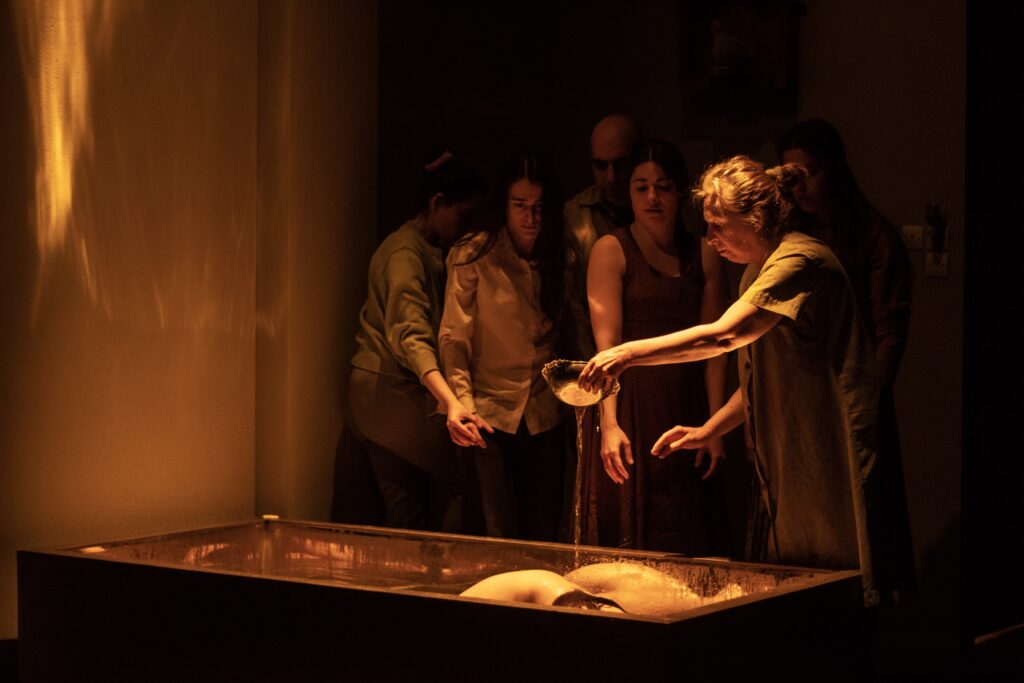
Goodbye, Lindita
Natasha Tripney: Let’s turn to Goodbye Lindita, by the young director Mario Banushi. I have a feeling i liked this more than most people. It’s a wordless piece about the rituals of grief and mourning, centring on the death of a young woman. Her family gather together to ritually bathe and display the body and to participate in the collective act of grieving. All of this is done without text. It is shown to us through movement and often highly striking and atmospheric stage imagery, the uncanny intermixed with the banal. The show created the sense of a space where spirituality and the supernatural coexist or overlap, a thin, porous place, between realms. While I think it evokes this very well, it did still like feel like the work of a young director. it didn’t feel wholly developed in how it was exploring these themes, but it did create pockets of strange beauty along with something more unsettling. Some of the motifs seemed drawn from folk horror, but there was also religious imagery. I would really like to find out more about his intentions in making this piece, which I know was inspired by the experience of death in his own family. While the show worked best on an atmospheric level, given this was only his second production, I was left feeling that this is a director with talent and I understood why it was part of the programme.
Andrej Čanji: My problem with this show is that I didn’t know how to look at it. It was hard to get emotionally involved with the death of a person we know nothing about and only care about in a broader, humanistic way. We see how the rituals of the funeral and mourning for this person go but we don’t know anything about the people doing the grieving. We’re just thrown into this context – and I was completely emotionally detached from the performance. So I thought, okay, maybe this should be more of a cerebral experience instead of an emotional thing. So I tried to see the performance as a kind of cerebral interrogation of these rituals, and the patriarchal structures and the religious beliefs that we see on stage. But I couldn’t tell what the attitude of the author was to this collection of customs. I didn’t know exactly what the purpose of this performance was. Why am I watching this? Is it an emotional, intimate therapy session that the author wants to share with us? Was it an anthropological study of the traditions of grief? What was this performance for? This was its fundamental flaw – it lacked focus and doesn’t seem to know exactly what it’s trying to achieve. It did have a strong visual identity, however, and offered an impressive collection of beautifully crafted scenes.
Borisav Matić: I partly agree with both of you, but I slightly lean towards Natasha’s opinion. I would say this performance is expressionist. There is a very striking visual style that represents the inner life of the characters, in particularly their grief. But my problem was also this sense of emotional detachment. I didn’t really go through the emotional journey that I think the director was aiming for. The strongest segment of the performance was definitely the visual part. But I agree with you, Andrej, that Banushi didn’t fully develop other segments of the performance. For a director who’s just 24 years old, I think it is a solid work, and though I feel the jury’s decision to give it the special award was not entirely justified, but I think that the performance rightly had a place in the programme.
Speaking about the awards, I would like to talk about #Jeanne, a show about a young woman who metaphorically represents both Joan of Arc and Greta Thunberg, but also other young female leaders of social movements. It’s a dark fairy tale that presents us with the gritty reality of life on the fringes of Swedish society. In the story, the impoverished working class live on one side of a lake, while on the other side rich people live in golden houses.
To me, one of the greatest disappointments of this year’s BITEF was that the jury gave the Grand Prix to #Jeanne. I expect there are several reasons to explain such a decision. One is a sense of, maybe not nostalgia, but appreciation that the former selector of BITEF Anja Suša came back to the festival as the director of this performance. The show also explores an important topic, that of class division in Swedish society and the recent shift to the right. The two main male characters are representatives of the impoverished working class. After work, they drink, watch television, and curse at migrants and women. They would likely vote for the Swedish Democrats, the radical right-wing party with Nazi roots that’s currently the second čargest party in Sweden, according to votes in the 2022 general election.
Jeanne is a young woman who is conscious of these class divisions, and who makes this rebellious step of going across the frozen lake to where the rich people live, trying to steal some gold from them and bring it back to the people in her neighbourhood.
The first 20 minutes or so of the performance are interesting – the story is told via symbolic dramaturgy. There are also documentary-style segments about giraffes, (which leads the audience to try and interpret the symbolic connection of giraffes to the rest of the show). Anja Suša and the playwright Ivana Sajko also raise questions about the function of art and theatre in today’s society, how they are bastions of middle-class privilege.
After this initial 20 minutes, there is little dramaturgical development until the end of the show. Essentially, this is not a story about Joan of Arc or any other female leader, because the two male narrators speak for 80 percent of the performance. There is no character development story about the titular female leader. We don’t see how her milieu shaped Jeanne because the only significant thing she does is decide to go across the lake, which she then falls inside and dies. And that’s it – a huge disappointment. The show felt as if it was stuck in this dramaturgical loop in which it repeats the same points instead of developing the structure.
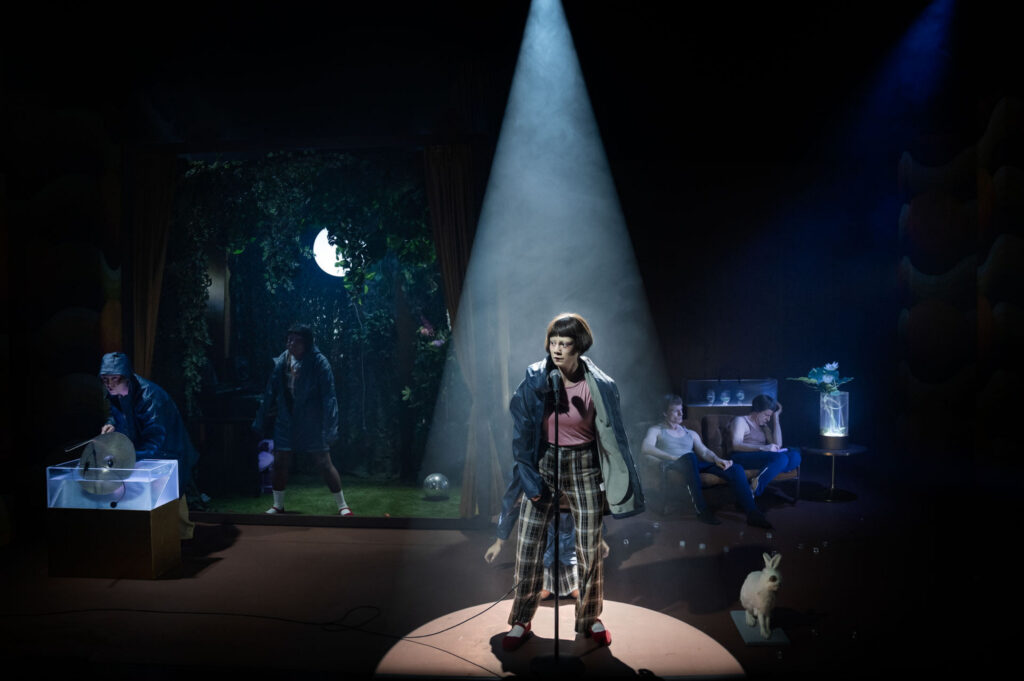
#Jeanne. Photo: Markus Garder
Natasha Tripney: I felt similarly disappointed. The scenes in which the actors lip-sync to what sounds like an AI-generated version of David Attenborough’s voice, first talking about giraffes, and then later talking about theatre itself, were very entertainingly presented, but only served to highlight how circular the rest of the play was. We also had a male voice given prominence in a show ostensibly about a young woman, whose story gets swallowed up just as Jeanne gets swallowed by the lake.
Andrej Čanji: Yes, I agree with you both, but I would add that, while the performance has all the necessary ingredients, the dish we were served was a disaster. For me, the biggest problem is that you have to force yourself to follow what is happening on stage. It’s a story presented in a difficult way and you have to struggle through it. It’s a mixture of satire and fairy tale, but it’s not as funny or witty as satire usually is. Yes, there are humorous elements, for example lip-syncing, but this is repeated several times, and each time it goes on too long. As for the fairy tale aspect, the execution of the storytelling was sluggish and monotonous. Even though they talk about class struggle, a theme that is very pertinent and something I like seeing explored in the theatre, after a while, I just didn’t care what was happening. It was a production full of symbols and metaphors, an allegory so densely stuffed that you don’t want to go through it at all.
“Sun and Sea stood out both for its concept and also how the concept was executed. It had a lot of the things that were lacking elsewhere”
Natasha Tripney on Sun and Sea
Borisav Matić: Let’s end our discussion by selecting our personal highs and lows from this festival. What did you enjoy the most and what were you most critical of?
Natasha Tripney: For me, I think Sun and Sea stood out both for its concept and also how the concept was executed. It had a lot of the things that were lacking elsewhere, it had wit. It had an interesting form. It used space in an interesting way, watched from the balcony of the gallery in which it was performed rather than sitting in a conventional proscenium arch setting. Perhaps it could have developed over the course of the show, but I found it satisfying on a number of levels and I came out of it having had a pleasing time, which was not the case with some other productions, particularly Frank Castorf’s The Divine Comedy, which was presented as the prologue to the main theatre programme. Five and a half hours was too much for me, not because of the length but because of its aggressive, indulgent and often quite sexist approach. Yes, I know Castorf is a legend of that German post-dramatic scene but despite admiring the skill and commitment of the performers and the fantastic way he used the whole of the theatre space including backstage and even outside areas, I was pretty ground down by it by the end.
Andrej Čanji: Sun and Sea was probably the highlight for me too. But since Natasha already talked about it, I will choose Singing Youth. I liked the concept of bringing together some contemporary quotes from today’s politicians and politicians from Hungary’s socialist past and showing the similarities. I think it gives a historical perspective that we often lack these days. And it makes clear how the propaganda of the authorities creates a kind of social engineering that society falls victim to then as now. All this is shown in a seemingly simple way by six young people dressed in white singing and performing very simple movements and choreography.
However, I think composer Máté Szigeti has done a brilliant job of composing for the politicians’ statements and combining them with a mixture of folk, propaganda and pop songs. The performers sing this polyphony perfectly. In the musical sense, it is a very complex performance and this aspect should not be neglected, especially because singing political slogans in this way effectively and impressively exposes their lies and manipulations. For the most disappointing performance, I would perhaps choose Jeanne, for reasons I have described.
Borisav Matić : For me, the festival started on a downer, with both The Divine Comedy and Children of the Sun, even though they are diametrically opposed shows. Children of the Sun is good in a technical way but unsuited to BITEF, because of its old-fashioned approach. As for Castorf, I would call this performance intellectual masturbation, but masturbation is a healthy and pleasurable activity while The Divine Comedy is neither. I would instead refer readers to Andrej’s nuanced review of the show while noting that I agree with the more critical part of his analysis.
As for my highlight of the festival, I would broadly single out the musical and dance performances which proved how both types of performing arts can be poignantly political. I’m thinking of Sun and Sea, Singing Youth and Desire to Make a Solid History…
Natasha Tripney: Before we conclude, it’s worth saying that for the reasons you articulated so well, at the beginning, Bora, this has been an atypical year for BITEF. it was a programme put together in very challenging circumstances because of external political factors. Which makes it difficult to form judgements about the selectors’ artistic outlook and what the festival might look like in the future. It will be next year’s festival where we will really get a sense of this leadership team and their tastes and where BITEF might be heading in the future years. So maybe it’s is better to think of this as an interim year, and look forward to what next year’s festival will bring.
Further reading: Interview with Anja Suša: “Theatre is the last bastion of the privileged.”
Further reading: Interview with Mateja Koležnik: “Art is a tool to open people’s minds.”
Further reading: Singing Youth: “Political systems embedded in culture are here to stay”

